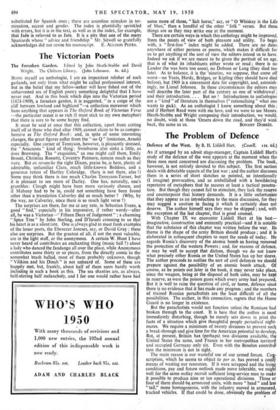Traveller in Spain
Spain. By Sacheverell Sitwell. (Batsford. 16s.) SPAIN has once more become what it was before the Civil War— one of the most popular holiday-grounds in Europe. in has the great advantage over most other countries that, if you go to the right part, you can be sure of a perfect climate in any month of the year. And also of a hearty welcome ; for the Spaniatds, despite their sufferings and preoccupations, still consider any foreigners whom they meet as their -personal guests, and spare no effort to make them feel at home. In this, as in all other things that really matter, they have not changed in the slightest.
Mr. Sacheverell Sitwell knows Spain well. It is over thirty years since he first .went there, and twenty-seven since he _dazzled us with the brilliance of Southern Baroque Art. On several occasions between the world wars, and also three times since 1945, he has travelled all over the country. His new book covers the greater part of it: Andalusia, Castile, Aragon and the Levante. His project, as he enunciates it in his introduction, sounds rather formidable: " It has been my attempt to proceed from province to province of the entire country dealing with its monuments in turn, and with no particular emphasis upon their date and style. In this way I believe that no building of any importance has been neglected, except the Escorial, of which I have attempted no description because it is part of universal knowledge." But the reader of those lines must not expect to find a slightly humanised Baedeker, with space carefully proportioned between competing attractions and with no omissions. There are pages of this book which stand out like the " bluebell `spirts- of Burgos " in their flood-lit splendour and leave the reader -quivering with expectation. Mr. Sitwell's genius, not,rnerely. for -description, but. for the creation- of atmo- sphere, finds unlimited possibilities in the .pages on Feria and Semana Santa in Seville (it is he, and not the reviewer, who, with unerring artistic instinct, puts them in the wrong order) and on the Valencian Fallas. (If he had been in Valencia last spring, by the way, he would have been able to see the street representations Of the miracles of St., Vincent Ferrer to which he refers with such curiosity.) It is for the glimpses which he gives of the less-known plaCes that those who have already some knowledge of Spain, and desire more, will be most grateful. Besides the famous cathedrals, he reminds us, there are " a host of lesser ones, including many of which the ordinary reader may scarcely know the names . . unparalleled, not for the stone vessels alone, but for the ,extra- ordinary nature and richness of their contents." His pages on the tapestries of Zamora Cathedral will open up one of these. He tells us, too, of historic villages and fossilised towns, no less remark- able and even less known—Santillana, Albarracfn, Medinaceli, Madrigal de las Altas Torres—of forgotten shrines, restored and
re-
populated, such as Poblet, and of mediaeval castles, such as Ciudad Rodrigo and Oropesa, which have been made accessible to all by the imagination, initiative and industry of the Direcci6n del Turismo.
One fault alone has to be found with Mr. Sitwell's book—the extraordinary inaccuracy, of its orthography, not all, unfortunately, attributable to slips in. proof-reading. There are pages with as many as four or five such mistakes, and there can be few with none. Italian prepositions. and even names, are light-heartedly
substituted for Spanish ones ; there are countless mistakes in ter- mination, accent and gender. The index is plentifully sprinkled with errors, but it is in the text, as well as in the index, for example, that Jahn is referred to as Jan. It is a pity that one of the many Spaniards whose " advice and friendship " Mr. Sitwell so gratefully acknowledges did not revise his manuscript. E. ALLISON PEERS.











































 Previous page
Previous page